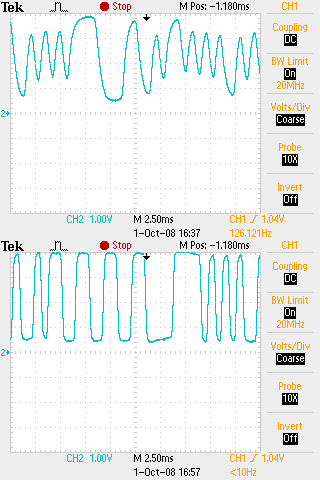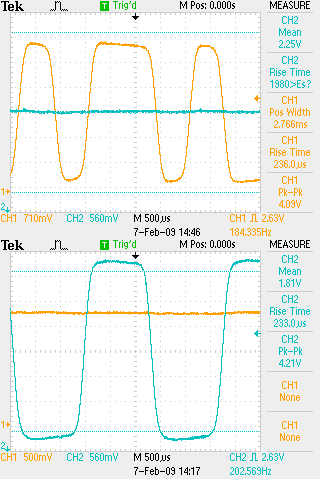 |
|
 Home Home
 Products Products
 Store Store
 Forum Forum
 Warehouse Warehouse
 Contact Us Contact Us

|
|
|
|
 
|
|
Author
|
Topic: DTS reader gives rounded rather than square waveform
|
|
|
|
|
|
|
|
|
|
|
John Hawkinson
Film God

Posts: 2273
From: Cambridge, MA, USA
Registered: Feb 2002
|
 posted 03-21-2009 07:45 PM
posted 03-21-2009 07:45 PM




We should have posted what happened here! Sorry about that.
Here's a view of the initial problem:

The image on top is the malfunctioning reader. The one beneath is the good reader. I think we spent too much time on introspection about this problem (specifically the rise time), worrying about whether it was a slow photocell, dying LED, etc., etc. DTS engineering suggested it was a bad cell.
But it turned out that adjusting the lateral alignment was all that was necessary to fix the slow rise time issue and get good performance out of this reader. I don't have quite as comparable scope captures (first capture is at 710mV/division, second is at 560mV/division), though:

I'm not sure what the takeaway is. "Sometimes you have to adjust the lateral alignment," I guess. This was not a problem specific to a particular print, either.
--jhawk
| IP: Logged
|
|
|
|
|
|
|
|
All times are Central (GMT -6:00)
|
|
Powered by Infopop Corporation
UBB.classicTM
6.3.1.2
The Film-Tech Forums are designed for various members related to the cinema industry to express their opinions, viewpoints and testimonials on various products, services and events based upon speculation, personal knowledge and factual information through use, therefore all views represented here allow no liability upon the publishers of this web site and the owners of said views assume no liability for any ill will resulting from these postings. The posts made here are for educational as well as entertainment purposes and as such anyone viewing this portion of the website must accept these views as statements of the author of that opinion
and agrees to release the authors from any and all liability.
|
|
|
|

 Home
Home
 Products
Products
 Store
Store
 Forum
Forum
 Warehouse
Warehouse
 Contact Us
Contact Us




 Printer-friendly view of this topic
Printer-friendly view of this topic








![[Smile]](smile.gif)
![[Wink]](wink.gif)








